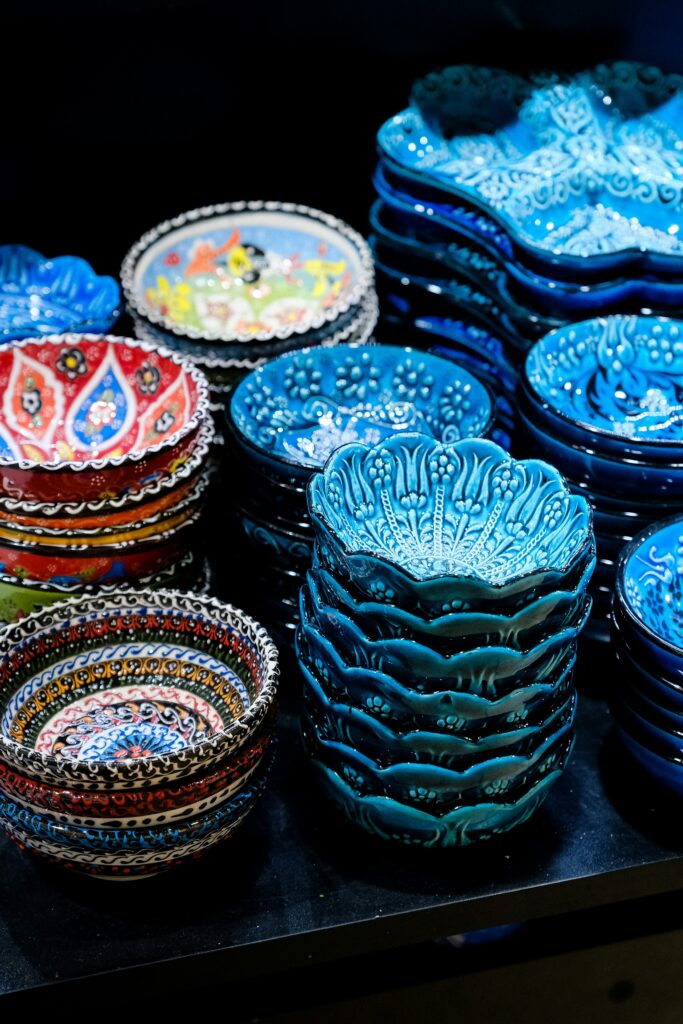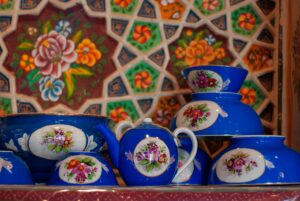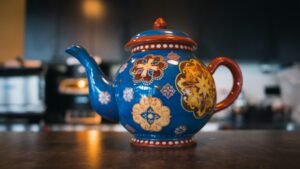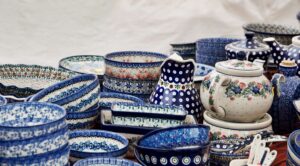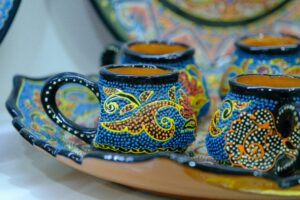Introduction
In South Asia’s heart, where age-old traditions still coexist with modernity, one art-the Multani Blue Pottery-has done more than just inspire the hands of artisans and the hearts of designers across the globe. This craft, originally crafted in Multan city of present-day Pakistan-has a glorious past extending over a thousand years. Once, the wares commanded regional markets and royal commissions; now, in 2025, the charm of Multani Blue Pottery is winning unprecedented recognition worldwide.
Table of Contents
The story this renaissance tells is not just one of nostalgia and cultural revival but also one of how to seamlessly carry the spirit of traditional craftsmanship into the realm of modern aesthetics and sustainable values. In this article, we shall take a closer look at why Multani Blue Pottery has found such a fast ascent into the international limelight today, what its special characteristics are, its history, and why it has become an item of choice for collectors, interior designers, and environmentally conscious consumers worldwide.
The Origins of Multani Blue Pottery: A Legacy Etched in Clay
The origin of this art form is among one of the major trade and culture centers along the Silk Road in the ancient city of Multan. It is believed that some Persian potters might have nurtured this craft in the Indian subcontinent during Mughal times. This pottery stands out from all others because it uniquely blends quartz powder, glass, and white clay, giving it an altogether different translucency and strength.Its beautiful cobalt-blue glaze with accents of white, green, and gold is inspired by Islamic geometric and floral patterns. The designs are painstakingly hand-painted with fine brushes. In truth, every item is a painstakingly wrought piece of art.
The old past did not have any bearing on the fading future of Multani blue pottery, shunned as it was by the rapid industrialization processes and the absence of patrons. However, revival efforts at various levels by artisans, NGOs, and the government have drawn attention to the art once more and aim to see a revival of this dying art in the international market.
What Makes Multani Blue Pottery Unique?
Many factors put multani blue pottery in addition to other ceramic traditions:
1. Non-per-composition
Unlike ordinary soil equipment, which depends a lot on the soil, multani blue pottery uses a holistic material that includes painted quartz, glass, and small amounts of white soil. This gives the finished product a smooth, shiny finish and makes it more durable than specific pottery.
2. Specific color palette
The signature feature of Multani Blue Pottery is its striking cobalt Blue glaze, supplemented with complex white detail. This color scheme is not onlya visual arrest, but also a symbol of spiritual and artistic depth contained in Islamic and Mughal design principles.
3. Crafts
Each piece is handmade and painted by hand, ensuring that no two objects are the same. This artisan quality appeals to those seeking authenticity and personality in the home decoration and collection.
4. Versatility in design
From plates and bowls to vases, lamps, and wall panels, Mulni Blue Pottery comes in different types. The adaptability makes it possible to use it in both functional and decorative references, making it ideal for modern interiors and traditional rooms.
Why Multani Blue Pottery Is Trending Globally in 2025
1. Rise of moral and durable consumerism
In 2025, consumers prioritize stability and moral production. Multani blue ceramics match these values completely. Since it is handmade using natural ingredients and low-energy stoves, it has a much smaller carbon footprint than mass-produced ceramics. In addition, buying Mulni Blue Pottery from local craftsmen helps preserve traditional crafts in rural communities.
2. Effect of interior design trends
In 2025, the interior design embraces bold colors, global textures, and crafty details. Multani blues and complex patterns of multi-blue ceramics provide a touch of luxury and cultural prosperity anywhere. Designers evenly include these pieces in minimal, maximalist, and Bohemian interiors, creating a fusion of the old world’s attraction and modern sophistication.
3. Celebrity and impressive approvals
Celebrities and influential people play an important role in popularizing blue ceramics globally. Social media has improved visibility to search for crafts behind utensils by displaying elegant table settings for YouTube videos from Instagram posts. The high-profile claim from fashion icons, lifestyle bloggers, and even Hollywood actors has helped bring this niche art form into the consciousness of the mainstream.
4. Cross-cultural appeal and beauty university
Multani resonates in cultures in geometric and floral motifs found in blue ceramics. Whether in Europe, North America, the Middle East, or Southeast Asia, the visual language of this craft speaks of universal topics of beauty, symmetry, and crafts. When globalization continues to blur cultural boundaries, multi-blue ceramics provide a solid relationship with inheritance without feeling out of place in the modern environment.
5. Limited version and customization options
With the emergence of privatization in consumables, many craftsmen now provide specially designed pieces. Buyers can choose specific patterns, color combinations, and even request individual inscriptions or monograms. This level of adaptation increases the appeal of multi-blue ceramics, especially in search of specificity among specific buyers.
6. Recognition in the international art and craft circle
Multani Blue Pottery has begun to receive praise for its international craftsmanship, design exhibitions, and cultural ceremonies. In events such as Milan Design Week, London Craft Week, and Dubai Design Week, exhibition windows appear as this art, which offers it to the wide audience. Museums and galleries also receive pieces for permanent collection to present their position as valuable evidence of cultural development.
The role of digital platforms and e-commerce
The digital revolution has played an important role in promoting multi-blue ceramics for global fame. Online Marketplaces, crafts-centered platforms such as Etsy and Novica, and direct-consumers of websites run by collaborative communities and non-governmental organizations have made it much easier than have already made it easier for people around the world to find and buy these crafts, taxes for people around the world.
Campaigns on social media, virtual workshops, and online storytelling have allowed craftsmen to share their travel, technique, and motivations directly with customers. This transparency promotes deep relationships between trust and manufacturers and buyers, which contributes to the growing demand for authentic, historical products.
Challenges and Opportunities Ahead
While the future of Multani looks promising for Blue Pottery, some challenges need to be solved to ensure long-term success:
1. Protection of traditional techniques
As demand increases, there is a risk of compromising the quality in favor of rapid production. It is necessary to maintain the integrity of the craft by training new generations of craftsmen and preserving traditional methods.
2. Market competition and copy products
The market is flooded with increasing popularity. The authentic multi-blue ceramics should be certified and marketed carefully to separate the parts of real crafts from factory-produced copies.
3. Each of ithe nfrastructure and markets
Many craftsmen still work with limited access to technology, logistics, and financial resources in remote areas. Strengthening supply chains, delivering microlon, and investing in digital reading skills will help them reach broad target groups and improve their livelihood.
4. Cultural sensitivity and intellectual property
When global brands use elements of multi-blue ceramics in their designs, there is an increasing need to protect the intangible rights of the original creators. Associated models involving craftsmen in CO-Design procedures can help ensure fair recognition and compensation.
Multani Blue Pottery in Contemporary Contexts: Beyond Decor
Beyond its beauty appeal, Multani-Blue pottery is reinvented innovatively:
Fashion articles: Pendant, earrings,gs, and multani get traction in the jewelry industry, made from blue ceramic pieces.
Architectural elements: Tiles and wall panels characterized by Multani design are included in luxury hotels, spas, and private homes.
Cultural education: Schools and universities integrate Multani-Blå ceramics into the art course to teach students about geometry, history, and sustainable practice.
These adjustments show that multi-blue ceramics are not only alive, but also develop and prove their relevance in today’s creative industries.
Conclusion: A craft connecting past, present, and future
In 2025, Multani is at the intersection of the Multani Blue Pottery tradition and innovation. Global popularity is not a passing tendency, but a reflection of a deep cultural change – a rapid digital world affects crafts, stability, and human touch. As more people want meaningful conditions through the objects they surround themselves with, Multani Blue Pottery provides a bridge between heritage and modernity. Each hand-painted curve and cobalt color tells a story about flexibility, beauty, and the permanent power of art.
Whether it appears in an apartment in Paris, a New York Penthouse, or a Moroccan Riad, Multani Blue Pottery reminds us that real elegance never goes out of style. And as we move on in a more conscious and connected future, this ancient craft is ready to shine more than ever.
Q1: What makes Multani Blue Pottery unique compared to other ceramics?
A: It uses a special clay mixture with quartz and glass, features hand-painted cobalt-blue designs inspired by Mughal and Islamic art, and is entirely handmade, making each piece one-of-a-kind.
Q2: Why is Multani Blue Pottery trending globally in 2025?
A: Its rise is fueled by sustainable consumer trends, interior design demand for artisanal crafts, celebrity influence, and digital platforms making it more accessible worldwide.
Q3: How is Multani Blue Pottery being preserved and adapted for modern use?
A: Through revival efforts, e-commerce visibility, collaborations with designers, and innovative applications like jewelry, architectural tiles, and educational programs.

